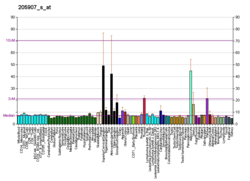Osteomodulin
Protein-coding gene in the species Homo sapiens
| OMD | |||||||||||||||||||||||||||||||||||||||||||||||||||
|---|---|---|---|---|---|---|---|---|---|---|---|---|---|---|---|---|---|---|---|---|---|---|---|---|---|---|---|---|---|---|---|---|---|---|---|---|---|---|---|---|---|---|---|---|---|---|---|---|---|---|---|
| Identifiers | |||||||||||||||||||||||||||||||||||||||||||||||||||
| Aliases | OMD, OSAD, SLRR2C, osteomodulin, osteoadherin, osteoadherin proteoglycan | ||||||||||||||||||||||||||||||||||||||||||||||||||
| External IDs | MGI: 1350918; HomoloGene: 3677; GeneCards: OMD; OMA:OMD - orthologs | ||||||||||||||||||||||||||||||||||||||||||||||||||
| |||||||||||||||||||||||||||||||||||||||||||||||||||
| |||||||||||||||||||||||||||||||||||||||||||||||||||
| |||||||||||||||||||||||||||||||||||||||||||||||||||
| |||||||||||||||||||||||||||||||||||||||||||||||||||
| Wikidata | |||||||||||||||||||||||||||||||||||||||||||||||||||
| |||||||||||||||||||||||||||||||||||||||||||||||||||
Osteomodulin (also called osteoadherin or osteoadherin proteoglycan) is a protein that in humans is encoded by the OMD gene.[5]
References
- ^ a b c GRCh38: Ensembl release 89: ENSG00000127083 – Ensembl, May 2017
- ^ a b c GRCm38: Ensembl release 89: ENSMUSG00000048368 – Ensembl, May 2017
- ^ "Human PubMed Reference:". National Center for Biotechnology Information, U.S. National Library of Medicine.
- ^ "Mouse PubMed Reference:". National Center for Biotechnology Information, U.S. National Library of Medicine.
- ^ "Entrez Gene: OMD osteomodulin".
Further reading
- Maruyama K, Sugano S (1994). "Oligo-capping: a simple method to replace the cap structure of eukaryotic mRNAs with oligoribonucleotides". Gene. 138 (1–2): 171–4. doi:10.1016/0378-1119(94)90802-8. PMID 8125298.
- Suzuki Y, Yoshitomo-Nakagawa K, Maruyama K, et al. (1997). "Construction and characterization of a full length-enriched and a 5'-end-enriched cDNA library". Gene. 200 (1–2): 149–56. doi:10.1016/S0378-1119(97)00411-3. PMID 9373149.
- Wendel M, Sommarin Y, Heinegård D (1998). "Bone matrix proteins: isolation and characterization of a novel cell-binding keratan sulfate proteoglycan (osteoadherin) from bovine bone". J. Cell Biol. 141 (3): 839–47. doi:10.1083/jcb.141.3.839. PMC 2132750. PMID 9566981.
- Buchaille R, Couble ML, Magloire H, Bleicher F (2000). "Expression of the small leucine-rich proteoglycan osteoadherin/osteomodulin in human dental pulp and developing rat teeth". Bone. 27 (2): 265–70. doi:10.1016/S8756-3282(00)00310-0. PMID 10913920.
- Strausberg RL, Feingold EA, Grouse LH, et al. (2003). "Generation and initial analysis of more than 15,000 full-length human and mouse cDNA sequences". Proc. Natl. Acad. Sci. U.S.A. 99 (26): 16899–903. Bibcode:2002PNAS...9916899M. doi:10.1073/pnas.242603899. PMC 139241. PMID 12477932.
- Lucchini M, Romeas A, Couble ML, et al. (2003). "TGF beta 1 signaling and stimulation of osteoadherin in human odontoblasts in vitro". Connect. Tissue Res. 43 (2–3): 345–53. doi:10.1080/713713482. PMID 12489179.
- Clark HF, Gurney AL, Abaya E, et al. (2003). "The secreted protein discovery initiative (SPDI), a large-scale effort to identify novel human secreted and transmembrane proteins: a bioinformatics assessment". Genome Res. 13 (10): 2265–70. doi:10.1101/gr.1293003. PMC 403697. PMID 12975309.
- Couble ML, Bleicher F, Farges JC, et al. (2004). "Immunodetection of osteoadherin in murine tooth extracellular matrices". Histochem. Cell Biol. 121 (1): 47–53. doi:10.1007/s00418-003-0608-2. PMID 14673660. S2CID 8160119.
- Gerhard DS, Wagner L, Feingold EA, et al. (2004). "The status, quality, and expansion of the NIH full-length cDNA project: the Mammalian Gene Collection (MGC)". Genome Res. 14 (10B): 2121–7. doi:10.1101/gr.2596504. PMC 528928. PMID 15489334.
- v
- t
- e


















